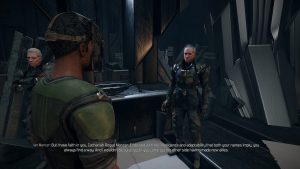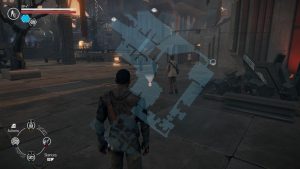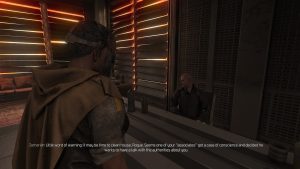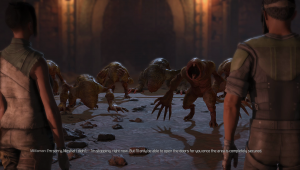Review | The Technomancer
In the distant future mankind has made it’s place within the stars, corporations claimed and divided the surface of Mars, but their ambitions fell victim to the deadly atmosphere and the mutated beasts and beings that were spawned by it. The pockets of humanity left surviving on the Red Planet do so under oligarchy governments, serving as the beating heart of the metal, riveted cities that now rival each other, arguing over the ruins of the species.
The Technomancer is the latest ARPG offering from Spiders, a twenty developer team working out of France, who seem zealously dedicated to rekindling the 3rd person RPG genre in a big way. Their two latest titles and their receptions couldn’t be more varied, Bound by Flame was divisive, currently sitting with a bold mixed as it’s user rating on Steam[–]. Meanwhile Mars: War Logs, a title with far too many parallels to The Technomancer to be a coincidence, sits with an extremely positive score, with only complaints of shallow towns, boring visuals, and awkward combat being the only majorly repeated negatives. The Technomancer, certainly builds on these points – but does the game compare to the vanguards of the genre; The Witcher, Dragon Age, and Dark Souls, or maybe should we ask does it need to?
 You are, as often in these games, the up-and-coming future hope of your entire people. In this instance you, as Zachariah Rogue Mancer, are different from the other Technomancers in that you were risen up, elevated, from an impoverished life on the streets – further still you are to be stationed domestically rather than being sent to the front lines to fight against other corporation’s forces as is the fate of most mancers.
You are, as often in these games, the up-and-coming future hope of your entire people. In this instance you, as Zachariah Rogue Mancer, are different from the other Technomancers in that you were risen up, elevated, from an impoverished life on the streets – further still you are to be stationed domestically rather than being sent to the front lines to fight against other corporation’s forces as is the fate of most mancers.
Abundance corperation controlled Ophir’s slums, underdark, tunnels, and exchange, serve as the first of several major hub areas within the game’s world. I’ve got to say I was quite impressed with the design of the city, the slum’s shanty towns, the underdark’s barracks, through to the exchange‘s checkpoints all feel lived in and worn down. Most importantly though there was a decent distribution of characters, civilians, and guards which served well as to negate one of my RPG pet-peeves – terrible population distribution. In fact, the next hub – a hidden merchant city – although smaller, still manages to fill most corners with enough variety to keep the place from feeling like a repetitive maze. This is handy, as their is no inter-hub fast travel system in the hubs – meaning you risk spending a lot of time backtracking.

One of the main reasons that there could be no fast travel options could well be the fact that the game operates a day/night cycle that ties into character rest (you get an XP boost for being well rested) and certain missions. Unfortunately these missions also highlight the absence of a wait function – instead tying the passage of time to simply waiting the one minute for the hour to pass, or travelling off to find the nearest bed to skip some time ahead. The latter, of course, is never a bad idea because of the experience boost – but, also because of the fact that any/most places you find a bed you’ll find a workbench, and crafting can be rather a big deal in the game.
As with any RPG there’s a focus in unlocking skills, perks, and stat upgrades as you level up – The Technomancer has a pretty cool combat system which we’ll get onto later, but for now all you need to know is that it’s best to focus on any one of the four combat trees in order to get stronger boosts and abilities as soon as possible. The negative of this is that certain enemies are simply better equipped in the game of rock-paper-scissors, and as such you need to balance the battlefield for when you change it up. This is where upgrades, and the tool bench, come in.
 There is a simply ridiculous amount of loot in the game world, chests and lockers to be broken into, enemies to be searched, mission rewards. A large share of this loot comes in the form of various materials. Depending on your crafting skills you can build modifiers for any slotted piece of weaponry or armour – there’s typically three options available for each level you have in crafting, and four levels of crafting. This might not seem like it gives much in the way of upgrades, however even at a low level you can find weapons and armour with three slots on them – and when you upgrade a staff to do more critical damage, or be more likely to electrocute an opponent, you will appreciate it.
There is a simply ridiculous amount of loot in the game world, chests and lockers to be broken into, enemies to be searched, mission rewards. A large share of this loot comes in the form of various materials. Depending on your crafting skills you can build modifiers for any slotted piece of weaponry or armour – there’s typically three options available for each level you have in crafting, and four levels of crafting. This might not seem like it gives much in the way of upgrades, however even at a low level you can find weapons and armour with three slots on them – and when you upgrade a staff to do more critical damage, or be more likely to electrocute an opponent, you will appreciate it.
That said, it is upgrades and items that are available through crafting. The game is relatively generous with armour and weapons as drops and rewards, although another thing that it does well is distribute merchants – with rarely more than 2/3 minutes to travel in a hub in order to find one. Weapons and armour can be broken down for a (percentage based) chance to get more materials, alternately they can be sold on at a merchant’s stall for serum, Mars’ currency.
Serum’s roll in the game is an interesting attempt to juxtapose greed against humanity – in a similar fashion to Bioshock’s Little Sisters – there are many ways to get serum, looting and pillaging, as rewards and through trading, however, whenever you knock an enemy unconscious in combat they don’t run off or fade away (until you have left) meaning that you can not only rifle through their pockets, but you can apply a syringe to them and remove their very essence as Serum. For the mutated remains of humanities animals, the moles, ostriches, and many more, this simply means more goodies for you, however for humans you take a karma hit.
I’m unsure of the role of Karma in the game, I personally hope that it’s tied into a drop system – a similar system to Bioshock’s instant reward vs long-term reward system. On thing for sure though is that this mechanic can be a little confusing at times, sending mixed messages in a game which gives the player a lot of freedom to approach and broach situations differently. The game often offered me chances to talk people down, use my conversational abilities to avoid a fight, or make a sinister person repent – however, sometimes the game took that option away, and where some early missions would offer up “Arrest”, others had no room for mercy, instead leaving the unconscious enemy covered with a mission marker on the mini-map.
 I normally play games that give chance for a moral path as an arbiter of order – playing the gullible protagonist who guards the poor, deliberately walks into traps, infiltrates criminal rings in order to take them down for justice. Technomancer delivers this exceptionally well, better than most even, at certain points. However, at other times it completely fails to manage this – likely due to failings in the design of certain parts of the game. One of the major factions of the game are the Vory, a criminal gang headed up by the memorabily, lawful-evil, Anton Rogue. A fairly predictable plot-twist sees your relationship with the man potentially turned on it’s head – however the game happily lets you dip your toes into his extortion or drug rackets and doesn’t present an option to double-back and work against the crime lord short of mild acts of sabotage in the earlier few missions. Similarly certain options followed the before mentioned issue of forcing me to have to extract serum from people, killing them, when I really felt there should have been a better way. At other times certain characters who I would have thought you would be able to target cannot be engaged in combat. I suppose in this way the game is a victim of the freedoms it has given you – and while they are minor deviations, they certainly risk jarring a certain moral play-style, which is a little immersion breaking.
I normally play games that give chance for a moral path as an arbiter of order – playing the gullible protagonist who guards the poor, deliberately walks into traps, infiltrates criminal rings in order to take them down for justice. Technomancer delivers this exceptionally well, better than most even, at certain points. However, at other times it completely fails to manage this – likely due to failings in the design of certain parts of the game. One of the major factions of the game are the Vory, a criminal gang headed up by the memorabily, lawful-evil, Anton Rogue. A fairly predictable plot-twist sees your relationship with the man potentially turned on it’s head – however the game happily lets you dip your toes into his extortion or drug rackets and doesn’t present an option to double-back and work against the crime lord short of mild acts of sabotage in the earlier few missions. Similarly certain options followed the before mentioned issue of forcing me to have to extract serum from people, killing them, when I really felt there should have been a better way. At other times certain characters who I would have thought you would be able to target cannot be engaged in combat. I suppose in this way the game is a victim of the freedoms it has given you – and while they are minor deviations, they certainly risk jarring a certain moral play-style, which is a little immersion breaking.
As well as the karma system for the killing, there’s also a reputation system for the major factions of the game, and for each of the game’s companions. These stats can yo-yo quite dramatically depending on how you play and chat with mission givers around the various hubs, and at times it certainly feels like you might well be funnelling yourself into a world split between half of the factions loving you, and the other half hating you – although with a little careful diplomacy you can negate this. This is probably the first feature that made me start drawing mental comparison’s to Obsidian’s Alpha Protocol, and Bioware’s Odyssey engine titles; Knights of the Old Republic, and Jade Empire.
 The Alpha Protocol parallel is the most important one here, the game had -alongside a moral/personality driven story- a quirky stats and ability system in place that encouraged a focus on set abilities and play-styles over a generalised splatter of low level abilities. In a fashion similar The Technomancer has six talents; Charisma, Traps & Lockpicking, Science, Crafting, Exploration, and Stealth. What each one makes you better at is obvious, however the importance of each of them is actually extremely fleeting – you don’t need a single level in one of them in order to finish the game. That said, I immediately leveled up lockpicking – spending my first three points as I got them in it – which meant that I was unlocking doors, chests and lockers ALL OVER the place. Seriously there are loads. As I played through the game my focus shifted to Charisma and then Crafting. What this meant is that regularly when dealing with scientists or chemicals – which surprisingly comes up a lot – my character was useless. I also never properly stealth killed, or pick pocketed a person.
The Alpha Protocol parallel is the most important one here, the game had -alongside a moral/personality driven story- a quirky stats and ability system in place that encouraged a focus on set abilities and play-styles over a generalised splatter of low level abilities. In a fashion similar The Technomancer has six talents; Charisma, Traps & Lockpicking, Science, Crafting, Exploration, and Stealth. What each one makes you better at is obvious, however the importance of each of them is actually extremely fleeting – you don’t need a single level in one of them in order to finish the game. That said, I immediately leveled up lockpicking – spending my first three points as I got them in it – which meant that I was unlocking doors, chests and lockers ALL OVER the place. Seriously there are loads. As I played through the game my focus shifted to Charisma and then Crafting. What this meant is that regularly when dealing with scientists or chemicals – which surprisingly comes up a lot – my character was useless. I also never properly stealth killed, or pick pocketed a person.
The opportunity to level your character comes thick and fast, I think on average I was levelling up once every half-an-hour that I played the game for, interestingly fast, but also necessary as the four combat trees – which you gain a single upgrade to per level – are each about 25 selections deep, with lots of passive upgrades as well as passive/active abilities that you can further enhance.
The first of the level trees is focused on your Technomancy. The Technomancers of this world are able to concentrate emotions into electrical charges, you start the game with the ability to fling a bolt across the battlefield, or electrify your weapons – however if you chose to further specialise then you can better armour yourself, become more deadly, or gain dangerous AOE spells.
The three remaining weapons choices are where the game gets really interesting.
 Combat in The Technomancer is based around a series of moves, dodges and stances. The first stance is The Warrior (the one I focused on) in which you use your quarterstaff for ranged melee attacks, sweeping AOE attacks, quick combo swipes or you simply kick your enemy to knock them off kilter. The Rogue is the quickest and most damaging of the stances, the dagger is minimal range, but it’s stun attack can also poison, and rather than having an AOE attack the Rogue will pull a pistol out and fire at the enemy they have targeted. Finally, the Guardian stance is the typical tank, blocking enemy attacks with a shield, bashing enemies with said shield to stun them, or smashing them with a mace between attacks. The three can be alternated between freely in combat, with the character not even needing two seconds in order to switch form – doing so can quickly change up the combat into your favour as all bar the bulkier, charging humanoid foes are one of the four stances.
Combat in The Technomancer is based around a series of moves, dodges and stances. The first stance is The Warrior (the one I focused on) in which you use your quarterstaff for ranged melee attacks, sweeping AOE attacks, quick combo swipes or you simply kick your enemy to knock them off kilter. The Rogue is the quickest and most damaging of the stances, the dagger is minimal range, but it’s stun attack can also poison, and rather than having an AOE attack the Rogue will pull a pistol out and fire at the enemy they have targeted. Finally, the Guardian stance is the typical tank, blocking enemy attacks with a shield, bashing enemies with said shield to stun them, or smashing them with a mace between attacks. The three can be alternated between freely in combat, with the character not even needing two seconds in order to switch form – doing so can quickly change up the combat into your favour as all bar the bulkier, charging humanoid foes are one of the four stances.
Each of the three stances also shares something in common, dodging. Dodging is probably the most critical part of combat, as most enemies can take away a third of your health if you are caught in a rough spot – as well as this many enemy groups include a ranged attacker who can quickly end any of your carefully planned combo ambitions should you not be willing to flip out of the way from the incoming bullet. Luckily it’s not entirely tough, bad news on that front, the combat menu will grind the game to almost static, and the game also generously doles out slow-motion moments that give you a little longer to plan our your next step, while enjoying your perfectly timed flip to safety.
 Combat isn’t fought alone, the game has five main companion characters, as well as a couple of stand ins. Each of the characters are structured around one of the combat archetypes, and will naturally level over time to match your progress – which is great when you’re doing a loyalty level with someone you’ve not used properly thus far, and they’re actually up to scratch. As with Zach you can manage their equipment and upgrades as well, which is also very good as it means that if you do focus on one specific aspect of combat you can give the better rewards you’ve received to your companions so they don’t go to waste.
Combat isn’t fought alone, the game has five main companion characters, as well as a couple of stand ins. Each of the characters are structured around one of the combat archetypes, and will naturally level over time to match your progress – which is great when you’re doing a loyalty level with someone you’ve not used properly thus far, and they’re actually up to scratch. As with Zach you can manage their equipment and upgrades as well, which is also very good as it means that if you do focus on one specific aspect of combat you can give the better rewards you’ve received to your companions so they don’t go to waste.
Companions actually slightly effect the progress of certain missions, not only contributing on an ability level (Scott, for instance will essentially give you a point in science) but in adding their own narrative, and talking to Zach. There were a few moments where characters got especially emotional, however when I initiated conversation with them they didn’t apologise or talk about it; instead launching into their default conversation – this was a little bit of a let down as we’ve all been rather spoiled by Bioware’s forays into inter-party relationships.
The outstanding strength of the game is it’s deep setting; from it’s clearly-mutated, perversions of Earth’s animals through to it’s busy slums, or sterile temples, the developers have managed an outstanding feat in building a thorough world. I especially enjoyed the class/task based surname assignment of the game, an interesting nod to what might happen to society should it break down in such a way.
I experienced no bugs with the game during my time playing, although there was some object popping after some of the longer loading screens, on occasion my computer slowed down as I approached a more built up area, although this normally quickly resolved.
The only real issue I took with the game was the transparent lines between morality in the game – I can drain anyone I beat down, but certain guards or evil-do-ers cannot be fought, I am penalised for ending the life of a truly evil individual when I was offered no chance to redeem or imprison them.
In conclusion, if you are looking for a sci-fi RPG with a solid setting and a decent amount of gameplay (About 35~ hours I would say) then I would certainly recommend The Technomancer.
Comments are closed.